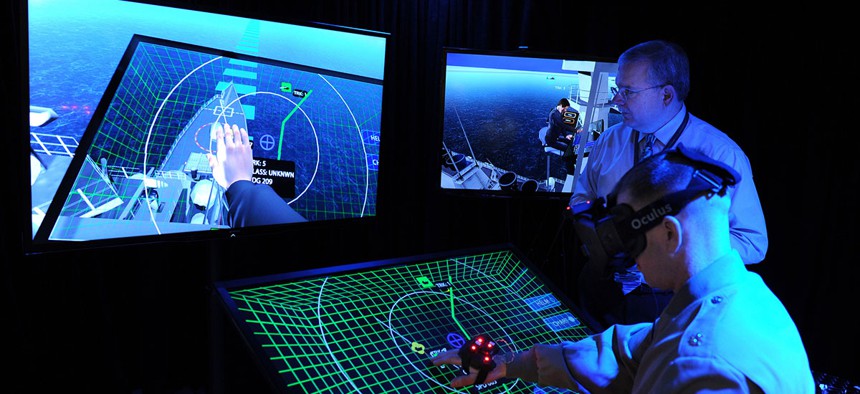From Word Processors to Cloud Computing: 40 Years of Tech at Department of the Navy

Jim Blesse, standing, from the Office of Naval Research (ONR), explains project BlueShark to Lt. Col. John Moore from the Marine Corps Warfighting Laboratory. U.S. Navy
It's come a long ways from 300 baud modems and original IBM PCs.
In the late 1970s, a young graduate from The George Washington University armed with an electrical engineering degree and a passion for computer science accepted a job at a Department of the Navy organization called the Naval Facilities Engineering Command. Now, over 40 years later, that graduate serves as one of the organization's deputy chief information officers and credits his longevity in the NAVFAC organization to simply keeping busy.
“I kept finding challenging things to do,” Tony Joyce says.
His day-to-day responsibilities include briefings and updates, conversations and staff meetings, and other supervisory chores. Joyce's team manages or supports portals and records management data sets, portfolios of software and business systems, software licenses, distribution, testing and certifications. The team also maintains oversight of a data center and a mainframe financial application, approves procurement requests, and coordinates rigorous investment decision management certifications.
» Get the best federal technology news and ideas delivered right to your inbox. Sign up here.
"On a given day, I may be working on preparations for IT system financial audits, data center consolidation, cloud hosting and migration, budgets and spending plans, or business system acquisition documentation," Joyce said.
Nextgov caught up with Joyce to chat about how technology has evolved over the years and where it’s been most transformative in government.
Nextgov: Looking back at the decades, what have been the most transformational technologies in government?
Tony Joyce: Computers. Thinking about what was available when I started, 300 baud modems and original IBM PCs, things like that, and compare to what we have now, it’s just an incredible improvement and the sophistication we have now isn’t anything I think anyone knew was possible—it was short of science fiction.
Nextgov: What were some challenges you encountered when implementing a new technology back then?
Joyce: One of my early efforts was word processing, so I bought one of the first dedicated word processors and expanded that to 15 or so centrally, one of each in our regional offices to do specifications. Before that, we were using 3270 emulators—straight up text editing specifications that were 50-page documents. Trying to do that over rather flaky networks in those days was really difficult. But it was better than doing it on a typewriter.
Deciding to get it, train people, work out how to use it, and try to work out some consistency in that, was probably the biggest challenge. Some people were afraid of the technology, but most of all, I think, is that people were afraid of change. That still is the case. Doing something substantially different is difficult for most people.
Nextgov: What technology came after word processing that you had to address?
Joyce: The next one I was involved with after that was computer graphics: CAD, CAM and mapping, which were very new at the same. The difficulty there was buying it: It took years to get the specifications. The acquisition process remains one of the most difficult parts of the business.
Nextgov: You’ve been an early adopter of technology. So, of which technology did you think, "This is going to change the world?"
Joyce: I’m not sure there was one; I keep looking for something exciting, new ways to do things better.
Nextgov: So, what’s the most exciting tech you work with today?
Joyce: I think cloud computing is probably the most exciting one. If it’s done right, it has enormous potential. We’re just standing up our first Amazon-hosted environment. If we get it right, the promise of being able to easily modify and scale is immense.
Even with cloud, I expect there to be certain limitations. But if we can capture most of that in how we do things … and then emulate how Amazon and Google are providing robust software services at incredible scale. I’ll use our analytics as an example. Our current on-premise stack and many of the queries against our analytical database take 20, 40 an hour or two to run. Being able to scale that query and run 1,000 processes to do that job in a minute as opposed to an hour.
Nextgov: What do you see on the horizon as the most important technologies to the Department of the Navy?
Joyce: I think data analytics in a variety of forms. Knowing what your cash position is in your budget at all times is a major hurdle and we haven’t gotten there yet. The other technology that will probably change things radically is … intelligent, well-structured text recognition [to] being able to effectively search through half million documents that I have in our portals.
Right now, the best technology we have is some sort of keyword, which means you got to apply metadata, and building that metadata is a huge burden on people, which means it doesn’t get done. So text mining in the government will have great promise because the government even more so than the private sector organizations operates off paper.
NEXT STORY: Estonia's New Digital Embassy



